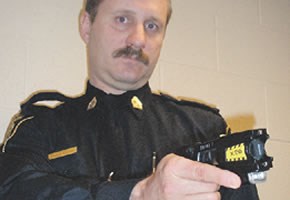BY LAUREL MYERS
Despite the public’s scrutiny and scattered disapproval of taser use by police services across Ontario, the Greater Sudbury Police Service has recently provided another example of why they believe the taser is an effective tool.
A man considered a high-risk individual and violent offender by police was in Sudbury court Wednesday to receive his sentencing on an attempted murder charge. Nicholas Aaron Martin – who is also facing a first-degree murder charge for the death of Jeffrey Mason – became assaultive and unco-operative with police while in transport from the holding cell to the courtroom.
“Because of the nature of the offense and his behaviour in the past, he is considerd a high-risk individual and required handcuffs and shackles,” said Greater Sudbury Police Service Superintendent Allan Lekun.
Yet before the handcuffs and shackles were placed on Martin, he assaulted the police officers escorting him.
“He became violent and uncontrollable and a taser was used,” the superintendent said, adding that Martin has also been charged with assault to an officer.
Tasers were first introduced to Ontario police services in 2003, offering officers across the province a less lethal option for enforcing the law and maintaining the peace.
Tasers work by sending an electrical voltage through a person that disrupts the body’s natural electrical impulses and results in the immediate loss of a person’s neuromuscular control and ability to perform co-ordinated action for the duration of the impulse.
“In my 25 years of policing, it’s the most effective tool we’ve ever been given to take somebody into custody safely,” said Greater Sudbury Police Service Deputy Chief Frank Elsner.
“Police officers have to be afforded the best tools to not only protect ourselves but the public.”
Following the recent deaths of two Canadians who were tasered by police, the safety of the devices has been brought to question.
Elsner explained the deaths attributed to taser use are, in fact, not caused by the taser itself.
“There’s a segment of society that has what’s known as excited delirium,” he said. “(Those with this condition) are in such an agitated state, their heart is racing and they’re very excitable.
“When they’re already in that excited state and we administer an outside stimulus, whether a taser or pepper spray or even a police officer jumping on top of the individual, their excited state may increase because of that interaction and they may have a heart attack.”
Elsner added that psychologists who have worked with people exhibiting excitable delirium have confirmed that, if they aren’t given a tranquilizer or sedative, the person can actually die without ever being touched.
“Unfortunately, we don’t know a person’s medical history before dealing with them,” he said.
“But I think the number of people’s lives that have been saved by using the taser vastly outnumbers any of the unfortunate deaths that we’ve seen.”
In a presentation to the Sudbury police, Dr. James Cairns, deputy chief coroner of Ontario, verified there had been no deaths attributed directly to the taser.
“If you get an electrical shock, it won’t kill you after the fact,” Elsner said, relaying Cairns’ presentation. “Electrical shock kills you instantly, not five minutes later, an hour later or a day later.”
Elsner added that none of the lawsuits filed for deaths caused by tasers have been successful.
Since the Greater Sudbury Police Service deployed the tasers, 91 incidents of use have been reported.
The devices are only distributed to the front-line supervisors and tactical officers and each is well-educated in the workings of their weapon and the effects it has.
“All the front-line officers that use the weapon have been tasered in one form or another,” Elsner said.
Lekun was one such officer and described the feeling of being tasered as “an intense transitory discomfort” with no lasting effects whatsoever.
“In my opinion, it is one of the most humane ways to control the behaviour and violent tendencies of people (being arrested),” he said.
The taser takes two to five seconds to take effect and is finished as soon as the individual drops to the ground. The device has a built-in computer tracking mechanism that records the number of uses, the length of use, the date and the time, ensuring every use is reported and that the tasers are not used excessively.
“It gives us one more option now,” Elsner said.
“Now we can be in excess of 20 feet away from someone who’s armed and we can taser them. Before the only alternative was to apply lethal force. In that sense (tasers have) saved many lives in this province.”
Join Sudbury.com+
- Messages
- Post a Listing
- Your Listings
- Your Profile
- Your Subscriptions
- Your Likes
- Your Business
- Support Local News
- Payment History
Sudbury.com+ members
Already a +member?
Not a +member?
Sign up for a Sudbury.com+ account for instant access to upcoming contests, local offers, auctions and so much more.



